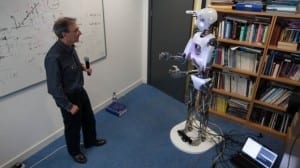In recent years, telepresence systems have become more common.
Unfortunately, most of them are little more than a videophone on top of a motorized stick. The EU Commission’s Community Research and Development Information Service (CORDIS) wants to change that, by developing a system called “beaming.” When fully developed, it should reportedly provide telepresence so real that for the operator and the people at the other end, it will be like the person is actually there.
The term “beaming” comes from the Star Trek transporter and the idea is the same – sending a person from one place to another instantaneously. Since teleportation isn’t possible, CORDIS is pursuing the next-best thing by creating a system that sends a person to the other side of the world in the form of a robotic avatar. Instead of staring at a monitor and moving a telepresence robot by remote control, beaming uses virtual reality technology and a humanoid robot with full sensory data and feedback mechanisms to provide a completely realistic experience.
Ideally, the avatar will be an android indistinguishable from a human – possibly one on which the features of the operator can be projected. What CORDIS ultimately hopes to achieve from its four-year project is a system wherein the operator can hook into the internet and send a virtual presence to a distant location, that presence being able to move and interact with people in a completely natural way as well as carry out any tasks a human being could.
That goal is still a long way off. This isn’t surprising, because such a system needs to be incredibly complex. It isn’t just a matter of streaming video over the internet. It involves robotics, cybernetics, neurology, haptics, computer graphics and a host of other technologies that are beyond anything existing today.
The reason for doing this is that current telepresence technologies are very unsatisfactory, according to CORDIS. Humans are social animals and, paradoxically, as telepresence technologies evolve they become more frustrating. Where a telephone conversation is something that people carry on comfortably because it’s just speech, video conferencing and telepresence robots make many people uncomfortable because they remind them of what is missing from this meeting that isn’t a real meeting.
“When we meet people in the flesh we can pick up on subtle cues – facial expressions, quirks, who is looking at who,” said Stephen Dunne from Starlab in Spain. “There is so much non-verbal communication that you miss, even with the highest quality video conferencing technology. You can’t shake hands or decide to look around the room, for example.”
via Gizmag – David Szondy
The Latest Streaming News: Telepresence updated minute-by-minute
Bookmark this page and come back often
Latest NEWS
Latest VIDEO








